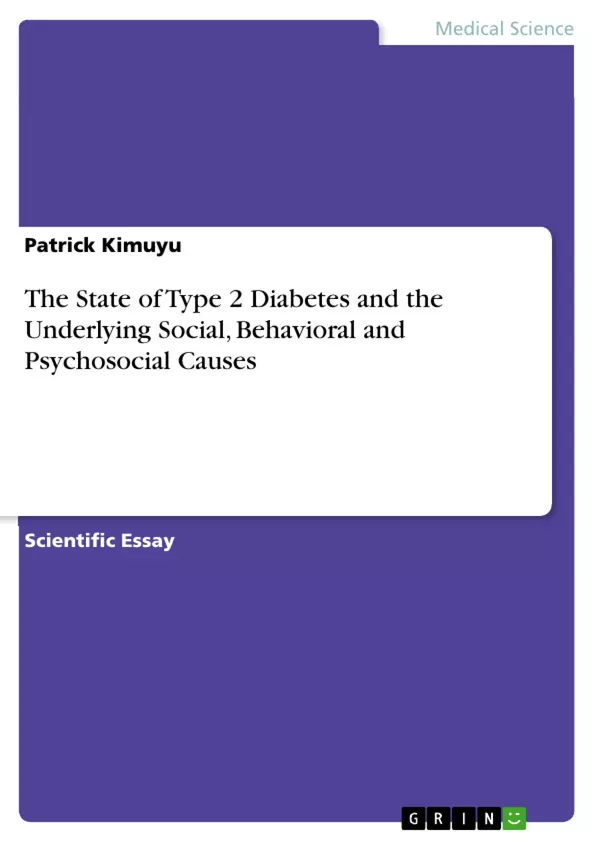Diabetes has become an immense challenge to the global public health systems with its burden approaching unbearable proportions. With an upward surge of diabetes rates, it is observed that diabetes has the highest disease burden compared to all the other non-communicable diseases (Kimuyu, 2016). Epidemiological studies reveal that hypertension and diabetes has contributed to the increase of cardiovascular disease, the world’s leading cause of death and morbidity (Tabish, 2007). One of the epidemiological concerns related to the upward trends of diabetes is the increase in incidence rates of Type 2 Diabetes (T2D) among children. Ordinarily, T2D has always been known as the ‘disease of retirement,’ implying that it occurs among adults but its trends have changed (Kimuyu, 2017). Therefore, this paper will give a comprehensive analysis of the development of T2D and suggest prudent steps to address the psychosocial proliferation of the disease.
Inhaltsverzeichnis (Table of Contents)
- Introduction
- Development of T2D in the U.S. Compared to Its Development in Developing Countries
- Comparison of T2D rates in the United States and New Jersey
- Cost of Treating T2D in the Community
- Prudent Steps to Address the Psychosocial Proliferation of T2D
- Steps to Address T2D in Nursing Homes
Zielsetzung und Themenschwerpunkte (Objectives and Key Themes)
This paper aims to provide a comprehensive analysis of the development of Type 2 Diabetes (T2D) and suggests prudent steps to address the psychosocial proliferation of the disease. It explores the rise of T2D both in the United States and developing countries, highlighting the impact of westernization and lifestyle changes. The paper further examines the socioeconomic burden of T2D, focusing on direct and indirect costs of treatment.
- The global prevalence and socioeconomic impact of T2D
- The role of westernization and lifestyle changes in the development of T2D
- The connection between psychosocial factors and the progression of T2D
- Prudent steps to address the psychosocial proliferation of T2D
- Specific strategies for managing T2D in nursing homes
Zusammenfassung der Kapitel (Chapter Summaries)
- Introduction: This chapter introduces the global challenge posed by diabetes, highlighting its growing burden and the increasing incidence of Type 2 Diabetes (T2D) even among children. The chapter emphasizes the need for a comprehensive analysis of T2D and the development of strategies to address its psychosocial aspects.
- Development of T2D in the U.S. Compared to Its Development in Developing Countries: This chapter explores the historical and current trends of T2D in the United States and developing countries. It examines the impact of industrialization, urbanization, and westernization on the emergence and prevalence of T2D in different regions.
- Comparison of T2D rates in the United States and New Jersey: This chapter compares the prevalence and incidence rates of T2D at the national level and in the state of New Jersey. It analyzes the demographic distribution of T2D within the New Jersey population and compares it to national statistics.
- Cost of Treating T2D in the Community: This chapter examines the social and economic consequences of T2D, highlighting the significant burden it imposes on communities through direct and indirect medical costs, lost productivity, and reduced quality of life.
- Prudent Steps to Address the Psychosocial Proliferation of T2D: This chapter explores the connection between psychosocial aspects and the development of T2D. It discusses the prevalence of depression among people with diabetes and outlines prudent steps to address the psychosocial proliferation of the disease, including substance abuse control, psychopharmacological therapies, psychological therapies, social support programs, and work-life balance.
Schlüsselwörter (Keywords)
The key topics of this work include Type 2 Diabetes (T2D), its prevalence and socioeconomic impact, the role of westernization and lifestyle changes in its development, the connection between psychosocial factors and T2D progression, strategies for managing T2D in various settings, and the importance of addressing the psychosocial proliferation of the disease.
- Arbeit zitieren
- Patrick Kimuyu (Autor:in), 2018, The State of Type 2 Diabetes and the Underlying Social, Behavioral and Psychosocial Causes, München, GRIN Verlag, https://www.grin.com/document/388759



